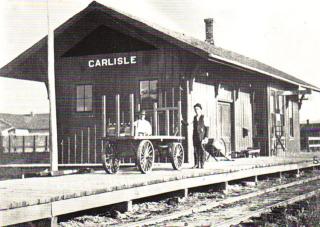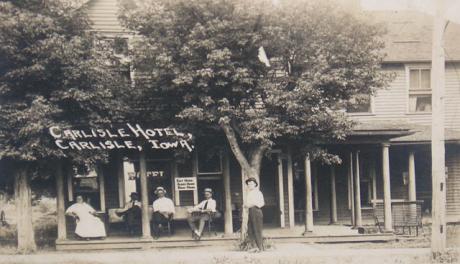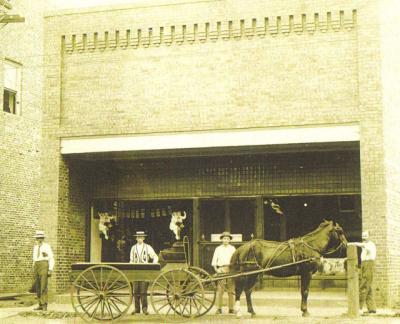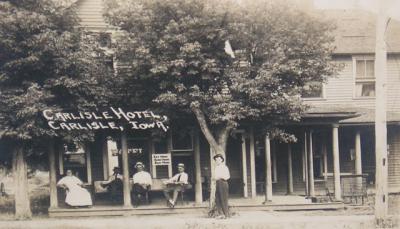History

The original settlement in the Carlisle area was called Dudley and was located at Keokuk’s Bend on the Des Moines River, approximately 3 miles east of present day Carlisle. Dudley was founded by John Griffin, the Assistant Surgeon of the Fort Des Moines Dragoons and laid out by Jeremiah Church in February, 1846 several months before the City of Fort Des Moines was first laid out in July, 1846. Dudley was destroyed by the great Flood of 1851.
That same year the settlement was relocated to the present site of Carlisle and surveyed by James Laverty for Jeremiah Church and Daniel Moore on the Moore homestead. The original town plat was the area bounded by School Street (then called South Street) on the south, Garfield Street (then called East Street) on the east, Elm Street (then called North Street) on the north and Fourth Street on the west. It was renamed Carlisle, after the city of the same name in Cumberland County, Pennsylvania.
During the 1860s the Iowa and Minnesota Railroad acquired right of way for a planned railroad line from Des Moines to the state line and eventually to Kansas City. The right of way was transferred to the Des Moines, Indianola and Missouri Railroad Company which constructed a line from Des Moines through Carlisle to Indianola in 1871. A branch to Winterset was added in 1872. These lines were consolidated into the Chicago, Rock Island and Pacific Railway Company in 1880.
 In 1912-13 the Saint Paul and Kansas City Short Line Railroad Company established the short line junction at Dean Avenue and SE 18th Street in Des Moines and constructed another line south through Carlisle. It extended through Hartford and Beech to Allerton, Iowa and became known as the short line between Des Moines and Kansas City. It was leased to the Rock Island and eventually consolidated into the Rock Island system in 1948.During the 1950s it was the route of the Twin Star Rocket passenger train between the Twin Cities and Houston.
In 1912-13 the Saint Paul and Kansas City Short Line Railroad Company established the short line junction at Dean Avenue and SE 18th Street in Des Moines and constructed another line south through Carlisle. It extended through Hartford and Beech to Allerton, Iowa and became known as the short line between Des Moines and Kansas City. It was leased to the Rock Island and eventually consolidated into the Rock Island system in 1948.During the 1950s it was the route of the Twin Star Rocket passenger train between the Twin Cities and Houston.
The Winterset branch was abandoned in 1958. Although the Indianola branch was abandoned in 1998, it was successfully rail-banked and converted into the Summerset bicycle/pedestrian trail. The Rock Island went bankrupt in 1979 and the Chicago and North Western Railroad acquired the main line. The CNW merged with the Union Pacific Railroad in 1995. The UP currently operates 12 to 15 trains daily through Carlisle and the line is known as the “spine line” because it parallels the spine of the North American continent.
 Carlisle’s original downtown was located on Market Street between 1st and 3rd Street but with the coming of the railroad in 1871, it was moved to its present location along School and First Streets. As the settlement began to grow the Bank of Carlisle was founded in 1895 and by the early 20th century, general stores, drugstores, hardware stores, livery stables, a hotel, a bakery, a barber shop, a doctor’s office, a harness shop, a blacksmith shop and other businesses.
Carlisle’s original downtown was located on Market Street between 1st and 3rd Street but with the coming of the railroad in 1871, it was moved to its present location along School and First Streets. As the settlement began to grow the Bank of Carlisle was founded in 1895 and by the early 20th century, general stores, drugstores, hardware stores, livery stables, a hotel, a bakery, a barber shop, a doctor’s office, a harness shop, a blacksmith shop and other businesses.
The first industry in the area was the Parmelee Lumber and Flour Mill which was built in 1843 at the foot of Watts Hill on the Middle River just east of Carlisle and operated into the 1870s. This mill provided lumber and shingles for the original buildings at Fort Des Moines. The Keeney Hoover mill was established near the original highway ford on the North River in the 1840s. The Carlisle Grist Mill which later became the Nicholson Flouring Mill was established in 1856 just east of downtown. The Nicholson Mill later burned to the ground in the great fire of 1888.
 Another major industry took advantage of the clay deposits along the North River. McKissick Brick and Tile operated on the west side of the tracks from 1908 to 1930 and Carlisle Brick and Tile operated on the east side of the tracks from 1936 into the 1960s. In the 1950s the Heartland Coop grain elevator and the General Mills flour mill and packaged foods plant were established at Avon and later annexed into Carlisle.
Another major industry took advantage of the clay deposits along the North River. McKissick Brick and Tile operated on the west side of the tracks from 1908 to 1930 and Carlisle Brick and Tile operated on the east side of the tracks from 1936 into the 1960s. In the 1950s the Heartland Coop grain elevator and the General Mills flour mill and packaged foods plant were established at Avon and later annexed into Carlisle.
A special thanks to Carol at the Carlisle Area Historical Society for the photos and information on this page.
